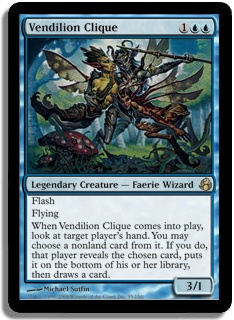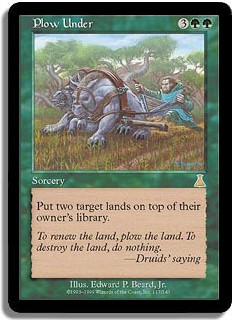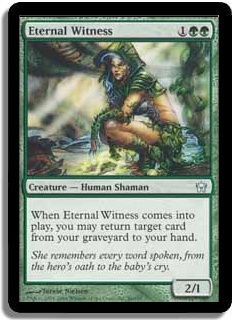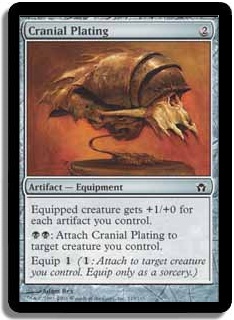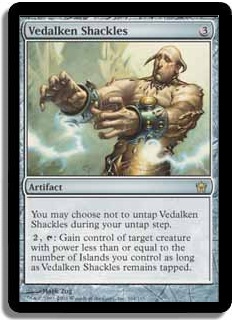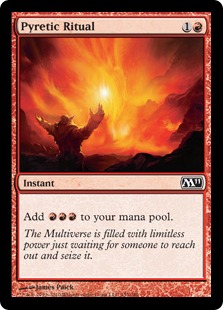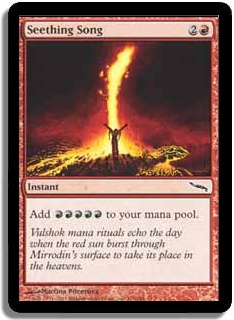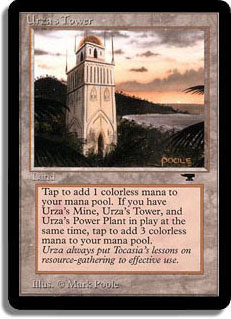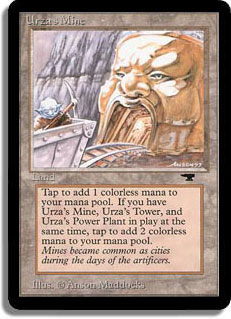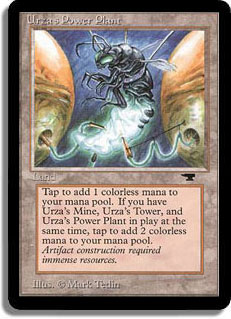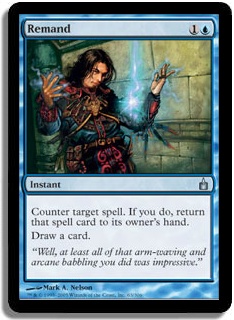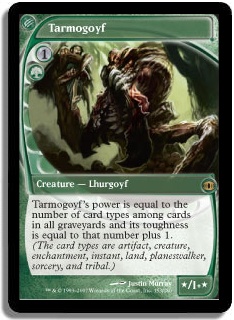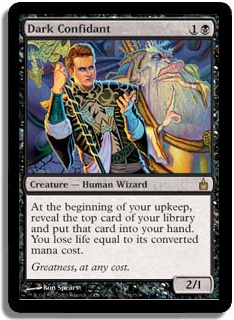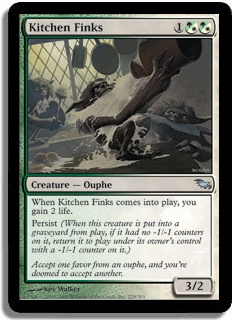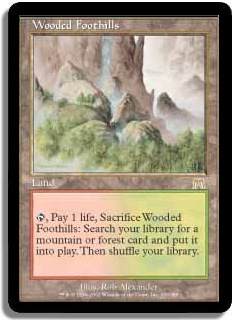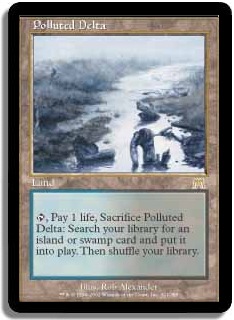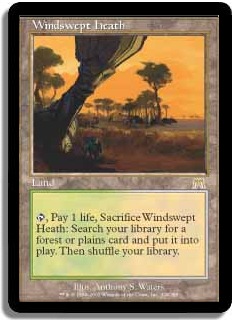Warning: Severe nostalgia incoming.
About two weeks ago, I posted the following question on Twitter:
"What cards currently legal in Modern are too good/miserable to reprint in Standard?"
The discussion it generated ended up being quite interesting, and the question was something I had pondered for some time. Here are a few of the cards that generated the most discussion or I found the most interesting to think about.
Keep in mind that I’m just talking about making cards Standard legal again. There are plenty of alternate methods of reprinting staples between Grand Prix promos, Judge foils, and standalone products like Commander and Planechase. If card availability starts becoming an issue for Modern, I’m sure it will be handled in an appropriate way.
Banned cards are also completely excluded from this discussion. There are maybe two of them that would be considerable.
Dredge, storm, and arcane are also off the table. The first two are possible to balance but very restrictive in design and extremely dangerous if done wrong, while the last does approximately nothing that other cards can’t accomplish. The same applies to the associated dredge powered cards, which play completely outside the rules of what most people think of as Magic.
Vendilion Clique
This was the card that sparked this whole line of thought. In my mind, this is a prime example of a card that is not only too powerful but doesn’t fit the direction the game is headed.
There’s the whole flash threat issue. Draw-go is not the direction Wizards is trying to push the game, and flash threats are a huge boon to the archetype. The ability to see whether you need the mana to present an answer before dropping a threat is a big deal.
This effect is further magnified in Standard, where decks are less redundant and missing a drop is a much more common occurrence. Also consider that the game is trending towards more decks with full curves, which are inherently more likely to brick on one turn’s play.
The ability on the card leads to a lot of inevitable game states where the game is already determined and both players are just going through the motions. I’ve gone through this rant before, but how often do you win when your opponent correctly tells you to keep your cards with Clique?
Even if it isn’t virtually ending the game, the ability is often a Time Walk attached to the already efficient tempo body. Back to the whole full curve thing, decks are already rarely super reliable at any given curve slot. The ability to "Duress" your opponent off their curve often forces them to use a turn doing something that is almost irrelevant by that point of the game. If you got to land the Clique on a previous turn where they had bricked, things get very bad for them very fast in a way that means they don’t get to play Magic.
It’s also very possible my opinion is biased by my personal experiences with the card.
Restoration Angel certainly suggests that high power flash creatures can still exist. Fettergeist implies that 3/x fliers for three aren’t outside of blue’s range. The biggest benefit of the previous two is actually the fact they are x/4s, whereas Vendilion Clique is not the best blocker. In terms of draw-go threats, it isn’t even that great of a clock.
Clique fits more into a tempo shell, which tends to result in interactive and interesting games. The whole inevitability thing may also have more to do with the power of the answers in the Faeries era, and the relevance of the tempo from shipping their on-curve drop may also have to do with how Faeries often won by accumulating a ton of Time Walks.
Stone Rain, Molten Rain, Cryoclasm, Fulminator Mage

This is a bit of an interesting conversation. The last time Stone Rain was in Standard, it spawned a bit of a monster. For those who haven’t seen the deck, this is an approximation of all the fun people were having:
4 Steam Vents
4 Shivan Reef
1 Oboro, Palace in the Clouds
8 Island
5 Mountain
3 Magnivore
4 Sleight of Hand
4 Eye of Nowhere
4 Boomerang
4 Stone Rain
3 Demolish
4 Compulsive Research
3 Tidings
3 Wildfire
4 Remand
I hope you weren’t planning on casting spells that cost more than four.
Of course, there is no way this deck could have existed without access to every land destruction effect it did have. It also wouldn’t have existed if Eye of Nowhere and Boomerang weren’t around to start sending your opponent back to the Stone Age on turn 2.
If you just look at all the past land destruction decks that have been successful, most of them have focused on starting the party on turn 2. Cutting all the one-drop accelerators that enable green decks to cast a turn 2 Stone Rain from the format is unrealistic, but if only one three-drop spell exists these decks can’t have the nut draw reliably enough to be obnoxious.
The return to the classics might even be welcome to bring back something along these lines, as there have been a lot of complaints about the lack of range in red spells. Land destruction exists now, but it’s not something people notice or care about. Name the land destruction spells in Standard off the top of your head, GO. How many of them are cards you even realize exist when not directly asked about them?
Of course, if there’s only one LD spell in the format, it should count for something. The best example I can think of is handling powerful utility lands. Take that, Moorland Haunt!
Of course, if that is the goal, why is the card you choose for the job Stone Rain? Why not something that rewards you for hitting the cards you are trying to answer or specifically aim for them, like Molten Rain or Fulminator Mage? Why not something that gives you extra utility, like Pillage or Vindicate? The only reason you would want Stone Rain is the pure nostalgia factor, especially when the double color cost of the other options helps reign in the turn 1 Elf, turn 2 kill your land starts.
Notice how Cryoclasm does none of the cool things and is all about mana screw. Sorry buddy, it’s not your day.
The same applies to Boomerang. Why print that card when you can make Into the Roil and provide a more interesting option when you aren’t targeting their land?
Plow Under
On the subject of making sure land destruction isn’t an issue, I hope Wizards never reprints this one (ironic, as the card is in Modern because it was reprinted). There are so many things wrong with it. It fits the 1-3-5 curve of green creature ramp and is undercosted for hitting two lands (see Rain of Salt or just two Stone Rain).
The worst offense? Once it hits, you are stuck cycling the same options you had for the last two turns. Things don’t actually get better, as you can’t draw out of it with ramp or a counter for their other midrange spells. If they ever resolve two, have fun doing nothing.
Well, that or the fact that it is a two for one on top of the tempo swing.
Plow Under only wasn’t miserable the first time around because the rest of the format was so overpowered. The second time around wasn’t the same way, and it should be enough to ensure there never is a third.
Eternal Witness
This card was Plow Under’s partner in crime, allowing the green decks to double up on it almost every time they drew a single copy. This card got brought up in the Twitter discussion, which shocked me as it was never on my radar. There is an argument that it lets control decks continuously loop their best spells in the matchup, which can be oppressive (see: Snapcaster Mage).
In my mind, my main concern is that rebuying planeswalkers might be a little too good. I’ve seen Snapcaster do a good impression with Regrowth in Legacy, and getting back a Jace or even Garruk Relentless while generating a blocker for it is quite hard to beat. Get back something too hard to kill and it just becomes obnoxious to deal with it twice (Garruk, Primal Hunter), but get back something that acts as a spell plus (Liliana of the Veil) and you are grinding a lot of value for only two cards.
Personally, I would be more interested in seeing what happens with Witness when it isn’t just rebuying land destruction or creating infinite loops with Crystal Shard, but that’s just me.
Cranial Plating
I haven’t really considered the ramifications of this card in a different format, but just historical evidence supports a no. This is probably a card where there isn’t a happy middle ground. It is either way too good or terrible.
Vedalken Shackles
Another potential offender from Fifth Dawn, and one of the first cards I noted as an example. Vedalken Shackles is a perfect example of what cards shouldn’t be. Once it resolves, playing creatures is no longer a viable option. You can try to flood the board, but it’s a battle of your best creature and all your cards against theirs while you are doing next to nothing to pressure the control deck. Start attacking and they get to trade off your creatures as chump blockers.
Repetitive and shuts off a major axis of the game? Not interested.
Splinter Twin, Kiki-Jiki, Mirror Breaker, Deceiver Exarch, Pestermite

Shunting off in a different direction, what about degenerate combo cards? Twin was part of the most overpowered Standard deck since the days of Arcbound Ravager, admittedly alongside a pair of individual offenders.
As bad as the parts are together, the pieces really aren’t bad on their own. Pestermite and Exarch are clearly fair without the other two. Splinter Twin didn’t do anything without Exarch, and speaking from personal experience Kiki-Jiki was extremely fun. Just keep all them away from each other and everyone will have a good time. You might also want to watch a couple other things with Kiki in the format, but two of those we have already brought up and are likely to already be carefully controlled (Eternal Witness and Fulminator Mage style cards).
Pyretic Ritual and Seething Song
The line here is similar to the discussion of Stone Rains. One Ritual is not enough to build a combo deck. Well, that disregards one or two specific cases, but Enduring Ideal was a cool and appropriately clocked kind of combo deck. It’s also worth noting that reprinting one of the existing Rituals is likely much better than making a new one in order to properly control the number that exist in Modern. Any more and Storm starts pushing the turn 2-3 barrier again.
So how do we pitch a case for Rituals in fair decks?
I remember the days of Arc Slogger, and Seething Song sure was fun then. All you need to make Rituals fun and fair is interesting big red guys. The addition of Looting effects to the color helps offset the late game card quality disadvantage quite nicely, as do cards like Thundermaw Hellkite.
If anything, I would lean towards Seething Song because of how much better the 3 → 5 ramp is for making a monster than just a one-mana boost. Of course, Rituals are scary business, and not seeing them ever again might just be better than taking that much of a risk.
Also, no Desperate Ritual because screw arcane spells.
Urza’s Tower, Urza’s Mine, Urza’s Power Plant
The other way to make extra mana from the last time we saw Seething Song. I’ll explain my opinion on this one with a story.
Back in the last Standard format where Tron was legal, I played Solar Flare at the Junior Super Series Championship. I posted an acceptable 8-5 record good for a mid-money finish.
The breakdown of my matches? 8-0 against the field, 0-5 against Tron. "The field" included multiple copies of the Magnivore deck I listed above. I would have rather played against the mono-land destruction deck with my tap-out control deck than play against Tron.
Those who have played Modern can likely relate. Play anything controlling or midrange and Tron will destroy you. This isn’t even exclusive to formats with Tutoring for the pieces; the Standard list’s best option was Compulsive Research. They didn’t even need that great of win conditions to "go big" either: just Keiga, Meloku, and a random red X spell.
Tron is extremely oppressive to a large segment of the metagame in a way that is absurdly hard to adapt to. Normally when a slightly smaller control deck has to beat a bigger one, being aggressive and disruptive is a very viable shift. In this case, you also have to contend with the fact they can just Tron up and make a monster on turn 4 beyond their inevitability. Land destruction has also fallen off the map, making the deck even harder to control.
Remand
It’s also very possible that a lot of my memories of Tron overpowering midrange and control are due to this card. Playing against a deck with Remand nearly obsoleted every card with a converted mana cost of four or greater. They spent two mana and no cards for a full turn of yours.
Think of all the other typical bounce effects and you will see one thing that distinguishes Remand: tempo is gained without a sacrifice of cards. It isn’t a perfectly live draw late game, but it still cycles. The only thing you actually sacrifice by playing Remand is your two mana, which is presumably less than they spent. See also what Snapcaster Mage does to Vapor Snag.
Given that the game is progressing towards a world where we are playing four- and five-drops across the board, Remand has no place in Magic. There could be Standard formats where it wouldn’t be insane, but even there it would only serve to hold back alternative strategies to extreme aggression.
Tarmogoyf and Dark Confidant
The other insane two-drops of the Remand era, and they still hold a top spot in every format they are legal. And I do mean actually every one now that people are playing creatures in Vintage.
The funny part is that neither of these cards was that absurd in Standard. They both greatly benefit from the expanded card pools of older formats.
Without fetchlands or cheap cantrips, it is hard to quickly ramp up Tarmogoyf. I wouldn’t expect it to break 4/5, and even then that is a mid to late game scenario of creature, planeswalker, sorcery, instant. It just wouldn’t be reasonable right now. Thought Scour and this card would not make for happy times.
Dark Confidant is also much fairer with full mana curves. Between the increased cost of life per card and the fact that a more board-oriented opponent is better positioned to fight the card, it was perfectly beatable in Ravnica Standard. It was best against other attrition decks, which incidentally was just the mirror match. The difference is unlike Umezawa’s Jitte or Bonfire of the Damned, the card was still quite good elsewhere and didn’t require specific inbred answers to handle.
The only reason I would be wary about reprinting these involves secondary market issues. A second large printing would likely plummet the price, but I’m no expert on how to manage those kinds of issues. Snapcaster Mage and Cavern of Souls are still over $20, so there is still room for marquee rares like there was in years past as long as they are that good, which Bob would be. As for Tarmogoyf, intermediate options would likely need to be explored before any actual reprint.
Kitchen Finks
If Bob and Tarmogoyf are on the outskirts of fair, Kitchen Finks is a central fixture of it. Barring a couple of incidental infinite combos that could use any persist creature, Kitchen Finks is a card only good for grinding value. It isn’t much different than Huntmaster of the Fells.
The main reason it won’t ever make it back into Standard is that it combines two block specific mechanics. It would be hard to find a time that persist and hybrid mana both show up again.
Fetchlands
The main argument against these is the Sperling point of view that they promote unnecessary amounts of shuffling. This causes a general slowing of tournaments and lots of logistical issues for a small amount of fixing benefit over alternatives.
I don’t really buy this argument. As long as this is accounted for when designing other potential shufflers, it shouldn’t add up to much. It was only an issue last time because they were compounded by Squadron Hawks, Stoneforge Mystic, and the Valakut land search cards.
I personally would want to see the Onslaught fetches back to complete the cycle and help Legacy out a bit. This would accomplish about the same as it did for Legacy: help fair decks play around nonbasic hate. There is a need to test the difference in life loss and see if adding the better mana makes aggro significantly worse by giving the control decks an extra life or two a game, but I doubt it.
Don’t expect to see them soon however. Assuming all the assumptions are correct, fetch-duals in Standard is tricky proposition. I could see it being interesting for the time between a core set release and part of the pair rotating in order to spice things up at a normally slow time of the year, but that’s the max amount of time I would want to see it for.
These are just a few of the many cards that might make interesting reprints or are worth discussing why they wouldn’t be. Any other thoughts on the subject would be appreciated. Here are a few cards I thought of but didn’t get around to talking about to spark the conversation:
@armlx on Twitter

